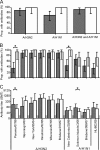Annual vaccination against influenza virus hampers development of virus-specific CD8⁺ T cell immunity in children
- PMID: 21880755
- PMCID: PMC3209321
- DOI: 10.1128/JVI.05213-11
Annual vaccination against influenza virus hampers development of virus-specific CD8⁺ T cell immunity in children
Abstract
Infection with seasonal influenza A viruses induces immunity to potentially pandemic influenza A viruses of other subtypes (heterosubtypic immunity). We recently demonstrated that vaccination against seasonal influenza prevented the induction of heterosubtypic immunity against influenza A/H5N1 virus induced by infection with seasonal influenza in animal models, which correlated with the absence of virus-specific CD8(+) T cell responses. Annual vaccination of all healthy children against influenza has been recommended, but the impact of vaccination on the development of the virus-specific CD8(+) T cell immunity in children is currently unknown. Here we compared the virus-specific CD8(+) T cell immunity in children vaccinated annually with that in unvaccinated children. In the present study, we compared influenza A virus-specific cellular and humoral responses of unvaccinated healthy control children with those of children with cystic fibrosis (CF) who were vaccinated annually. Similar virus-specific CD4(+) T cell and antibody responses were observed, while an age-dependent increase of the virus-specific CD8(+) T cell response that was absent in vaccinated CF children was observed in unvaccinated healthy control children. Our results indicate that annual influenza vaccination is effective against seasonal influenza but hampers the development of virus-specific CD8(+) T cell responses. The consequences of these findings are discussed in the light of the development of protective immunity to seasonal and future pandemic influenza viruses.
Figures




References
-
- Belshe R. B., et al. 2007. Live attenuated versus inactivated influenza vaccine in infants and young children. N. Engl. J. Med. 356: 685–696 - PubMed
Publication types
MeSH terms
Substances
LinkOut - more resources
Full Text Sources
Medical
Research Materials

